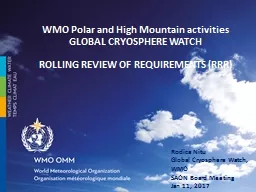

GLOBAL CRYOSPHERE WATCH ROLLING REVIEW OF REQUIREMENTS RRR Rodica Nitu Global Cryosphere Watch WMO SAON Board Meeting Jan 11 2017 SUMMARY WMO Priorities Global Cryosphere Watch Rolling Review of Requirements ID: 811911
Download The PPT/PDF document "WMO Polar and High Mountain activities" is the property of its rightful owner. Permission is granted to download and print the materials on this web site for personal, non-commercial use only, and to display it on your personal computer provided you do not modify the materials and that you retain all copyright notices contained in the materials. By downloading content from our website, you accept the terms of this agreement.
Slide1
WMO Polar and High Mountain activities
GLOBAL CRYOSPHERE WATCHROLLING REVIEW OF REQUIREMENTS (RRR)
Rodica Nitu
Global
Cryosphere Watch,
WMO
SAON Board Meeting
Jan 11, 2017
Slide2SUMMARY
WMO Priorities
Global Cryosphere Watch
Rolling Review of Requirements
Opportunities for collaboration GCW-SAON
Slide3WMO Priorities 2016-2019
Disaster Risk ReductionGlobal Framework for Climate ServicesWMO Integrated Global Observing SystemAviation Meteorological ServicesPolar and High-mountain Regions: Improve meteorological and hydrological monitoring, prediction and services, by
:
(
i
)
operationalizing
the Global Cryosphere Watch;
(ii) understanding the implications of changes on the global weather and climate patternsCapacity DevelopmentWMO Governance
Slide4GCW Activities
(what is GCW doing, or what’s happening that wouldn’t otherwise happen)
Fundamental contribution to
GEOSS
;
refining
cryosphere
observational
requirements for WIGOS OSCAR ;network of surface observations, with
"CryoNet“ at its core;
collating/establishing
measurement guidelines
and best practices;
engaging in and supporting
intercomparisons of instruments and (satellite) products
, e.g.,
GCW Snow Watch
(and SnowPEx);
SPICE
e
nable
access to data and metadata
through GCW portal
;
Use the WMO data regulatory framework to enable the development and implementation of
data/metadata standards
contributing
to WMO’s space-based capabilities database (with PSTG);
producing
unique hemispheric products
, e.g., “snow anomaly trackers
”;
engaging in
historical data rescue
(e.g., snow depth);
building a
glossary of
cryospheric
terms
;
Slide5CryoNet
network of
cryospheric
in-situ
observations
.
extensive monitoring through GCW (standardized) practices;
cryospheric
data
for improved process
understanding
and modelling;
calibration
and validation data for satellite data;linking cryospheric ground truth observations to cryospheric models;training.
Slide6WMO Rolling Review of Requirements
https://www.wmo.int/pages/prog/www/OSY/GOS-RRR.htmlReview of technology free requirements for observations within each area of applicationReview of observing capabilities (existing, planned) of observing systems (surface, space based)Critical review of the extent to which the technology deliver the requirementsStatement of Guidance: Inform on the extent to which the requirements are met by the identified systemsInforms the dialogue with the observing system developing agencies, influencing future research
Feasibility and affordability
Slide7Application Areas
Global NWP;High resolution NWP;Nowcasting and very short range forecasting;Subseasonal to longer term prediction;Forecasting atmospheric composition;Monitoring atmospheric composition;Provide atmospheric composition information to support services in urban and populated areas;
Aeronautical meteorology;
Ocean
applications;
Agriculture meteorology;Hydrology;
Climate monitoring;
Climate
applications;Space weatherGCW is an evolving area: requirements under development
Slide8RRR Processhttp://www.wmo-sat.info/oscar
/ Requirements defined in terms of:Horizontal and vertical resolutionFrequency of observationsTimeliness (delay in availability)Uncertainty (acceptable RMS errors, limitations or bias)Values:
goal
,
threshold
,
breakthrough
.
WMO collects requirements for observationsCatalogues the current and planned provisions of observationsGenerates a database on User Requirements and Observing System Capabilities Accessible via WMO website through the Observing Systems Capabilities Analysis and Review Tool (OSCAR).
Slide9OSCAR Database
Slide10Cryosphere variables
CryoNet Team meeting, Sept 20-22, 2017 http://www.wmo.int/pages/prog/www/OSY/Reports/GCW-index.htmlRecommended and desirable variables by componentNext steps: complete the assessment of attributes of variables
Slide11GCW DATA PORTAL
Engagement with Arctic Data CommitteeExchange cryosphere data, metadata, information and analyses among a distributed network of providers and users.
gcw.met.no
The
GCW Data Portal is part of WIS
,
a
Data Collection and Production Centre
and
is interoperable with data
centres
.
YOPP data management builds on GCW data management
Slide12GCW Steering GroupMeeting: Jan 16-19, 2017, Cambridge, UK
Focus on implementation: potential for collaboration with CON SAONDefine GCW as a ProgrammeData ExchangePartnershipsNew productsExpansion of the GCW Observing Network
Slide13GCW partners:
Global Precipitation
Climatology
Centre
Collaboration and cooperation with partners is
essential
to successfully
conduct
GCW activities at the international, regional and national
levels.
Partners include, but not limited to:
Slide14GCW sponsors:
Slide15Thank you